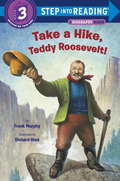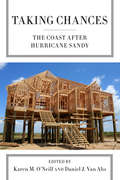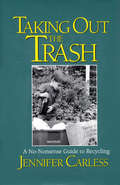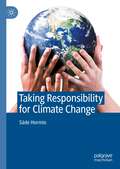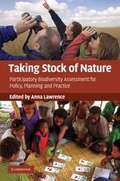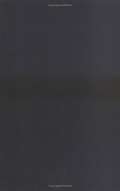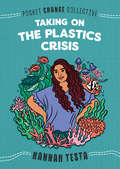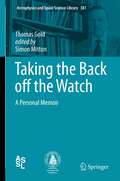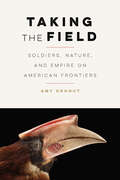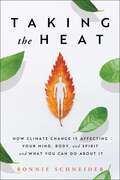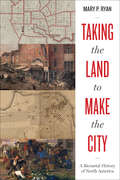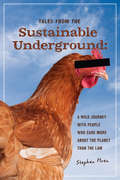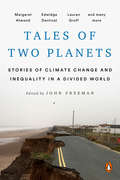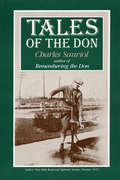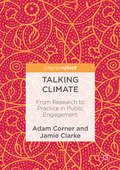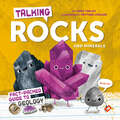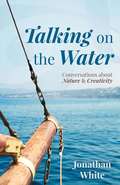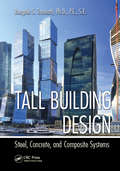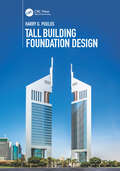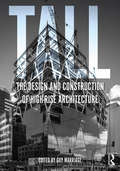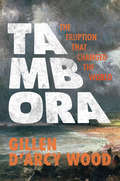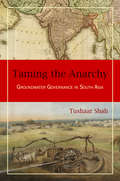- Table View
- List View
Take a Hike, Teddy Roosevelt! (Step into Reading)
by Frank Murphy illustrated by Richard WalzA Step 3 Step into Reading Biography Reader about Teddy Roosevelt and his efforts to protect our environment and establish national parks. Teddy battled asthma all his life, and the list of things he shouldn't do was long. But when people told him "you can't," he set about proving them wrong. This book focuses on his inexhaustible enthusiasm and his commitment to preserving America's natural resources. Step 3 Readers feature engaging characters in easy-to-follow plots about popular topics. For children who are ready to read on their own.
Taking Care of Nature: This is our Planet (A First Look At #33)
by Pat ThomasThis reassuring picture book makes children aware of how unique our planet is and why we need to look after it. This book is written from the perspective that we take care of the things we care about and that the rules for taking care of the environment are little different from the rules of everyday living and getting along with others. 'What about you?' questions throughout are useful prompts for understanding things from your child's point of view. Charmingly clear illustrations give readers immediate access to complex situations and feelings Notes for parents and teachers at the back of the book provide valuable advice for how to share this book with your child or class.The superb A First Look At series consists of a number of reassuring picturebooks that give advice and promote interaction between children, parents, and teachers on a wide variety of personal, social and emotional issues Written by a trained psychotherapist, journalist and parent, and illustrated by an experienced children's book artist, this title is part of an acclaimed and successful series of picture-book non-fiction for Early Years. Books in the series give advice and promote interaction between children, parents, and teachers on a wide variety of personal, social and emotional issues. They are excellent tools for teachers to use during classroom discussions.
Taking Care of Where We Live: Restoring Ecosystems (Orca Think #17)
by Merrie-Ellen WilcoxKey Selling Points Introduces readers to STEM concepts, such as ecology and ecosystems, ecosystem services, biodiversity, ecological degradation, climate change, deforestation and how ecological restoration works. Also looks at the role ecological restoration can play in social issues such as fighting poverty and food insecurity. Readers will discover the importance of Traditional Ecological Knowledge (TEK) and how Indigenous knowledge is key to understanding and restoring ecosystems. The United Nations Decade on Ecosystem Restoration launched on June 5 (World Environment Day), 2021, in response to a proposal from more than 70 countries around the world. It encourages young people to become part of #GenerationRestoration. Features restoration projects in different ecosystems (e.g., forests, wetlands, grasslands, islands and marine ecosystems) around the world, such as the Great Green Wall in Africa (the world's largest ecological restoration project), the Ten Billion Tree Tsunami project in northwestern Pakistan (aiming to restore the region's forests and fight the effects of climate change) and the Maiden Island Reef in the Caribbean (the world's largest marine habitat restoration, including both coral reefs and mangrove habitat). The author has a diploma in the restoration of natural systems from the University of Victoria. She spoke with leading experts in the field of ecological restoration during her research for this book. She's published two Footprints titles with Orca, What's the Buzz? and Nature Out of Balance.
Taking Chances: The Coast after Hurricane Sandy
by Joanna Burger Tammy L. Lewis Kenneth A. Gould Robert B. Gramling Mark Alan Hewitt Mariana Leckner Bonnie Mccay Briavel Holcomb Angela Oberg Melanie Mcdermott Steven G. Decker Professor Karen M. O'Neill Patricia M. Clay Daniel Redlaswk Frank A. Felder Clinton J. Andrews Adelle Thomas Lisa L. Colburn Larry Niles Daniel Baldwin Hess David A. Robinson Brian W. Conley James K. Mitchell Ashley Koning Shankar Chandramowli Daniel J. Van Abs Julia FlaggHumanity is deeply committed to living along the world's shores, but a catastrophic storm like Sandy--which took hundreds of lives and caused many billions of dollars in damages--shines a bright light at how costly and vulnerable life on a shoreline can be. Taking Chances offers a wide-ranging exploration of the diverse challenges of Sandy and asks if this massive event will really change how coastal living and development is managed. Bringing together leading researchers--including biologists, urban planners, utilities experts, and climatologists, among others--Taking Chances illuminates reactions to the dangers revealed by Sandy. Focusing on New Jersey, New York, and other hard-hit areas, the contributors explore whether Hurricane Sandy has indeed transformed our perceptions of coastal hazards, if we have made radically new plans in response to Sandy, and what we think should be done over the long run to improve coastal resilience. Surprisingly, one essay notes that while a large majority of New Jerseyans identified Sandy with climate change and favored carefully assessing the likelihood of damage from future storms before rebuilding the Shore, their political leaders quickly poured millions into reconstruction. Indeed, much here is disquieting. One contributor points out that investors scared off from further investments on the shore are quickly replaced by new investors, sustaining or increasing the overall human exposure to risk. Likewise, a study of the Gowanus Canal area of Brooklyn shows that, even after Sandy swamped the area with toxic flood waters, plans to convert abandoned industrial lots around the canal into high-density condominiums went on undeterred. By contrast, utilities, emergency officials, and others who routinely make long-term plans have changed operations in response to the storm, and provide examples of adaptation in the face of climate change. Will Sandy be a tipping point in coastal policy debates--or simply dismissed as a once-in-a-century anomaly? This thought-provoking collection of essays in Taking Chances makes an important contribution to this debate.
Taking Out the Trash: A No-Nonsense Guide To Recycling
by Jennifer CarlessTaking Out the Trash is a practical and useful guide to how individuals, businesses, and communities can help alleviate America's garbage crisis.
Taking Responsibility for Climate Change
by Säde HormioThis book proposes that it is not only states and international bodies that have a responsibility to take action toward mitigating climate change. Other collective agents, such as corporations, need to also come onboard. Additionally, the book argues that climate change is not solely a problem for collective agents, but also for individuals, as they are members of collectives and groups of several kinds. Therefore, framing climate change responsibility exclusively from either the collective or the individual perspective leaves out something crucial: how we all are influenced by the collectives we belong to and how, in turn, collectives are influenced by individuals. The focus of the book is on areas of climate change responsibility that are often left out of the picture or get too little attention in climate ethics, such as carbon inequality within countries. But why should any theoretical arguments about normative issues matter when we have a real-life climate crisis on our hands? Säde Hormio argues that ethical arguments have an important role in setting climate policy: they can highlight what values are at stake and help ground normative arguments in public deliberations.
Taking Stock of Nature: Participatory Biodiversity Assessment for Policy, Planning and Practice
by Anna LawrenceIn a world of increasing demands for biodiversity information, participatory biodiversity assessment and monitoring is becoming more significant. Whilst other books have focused on methods, or links to conservation or development, this book is written particularly for policy makers and planners. Introductory chapters analyze the challenges of the approach, the global legislation context, and the significance of the Millennium Ecosystem Assessment. Specially commissioned case studies provide evidence from 17 countries, by 50 authors with expertise in both biological and social sciences. Ranging from community conservation projects in developing countries to amateur birdwatching in the UK, they describe the context, objectives, stakeholders and processes, and reflect on the success of outcomes. Rather than advocating any particular approach, the book takes a constructively critical look at the motives, experiences and outcomes of such approaches, with cross-cutting lessons to inform planning and interpretation of future participatory projects and their contribution to policy objectives.
Taking Sustainable Cities Seriously: Economic Development, the Environment, and Quality of Life in American Cities
by Kent E. PortneyTaking on the Plastics Crisis (Pocket Change Collective)
by Hannah TestaPocket Change Collective was born out of a need for space. Space to think. Space to connect. Space to be yourself. And this is your invitation to join us."Taking on the Plastics Crisis delivers straightforward advise for getting involved in the global movement to eliminate single-use plastics." -- Booklist, Starred Review"Brief yet inspirational, this story will galvanize youth to use their voices for change."--Kirkus Reviews"Taking on the Plastics Crisis is a sobering and inspiring read by a brilliant young change maker. Now is the time for all of us to come together to solve the plastic pollution crisis."--Ed Begley Jr. (actor and environmental activist)In this personal, moving essay, youth activist Hannah Testa shares with readers how she led a grassroots political campaign to successfully pass state legislation limiting single-use plastics and how she influenced global businesses to adopt more sustainable practices. Through her personal journey, readers can learn how they, too, can follow in Hannah's footsteps and lower their carbon footprint by simply refusing single-use plastics.Pocket Change Collective is a series of small books with big ideas from today's leading activists and artists. In this installment, youth activist Hannah Testa, the founder of Hannah4Change, chronicles both her personal and political mission to save the Earth's oceans by limiting single-use plastic products.
Taking the Back off the Watch
by Simon Mitton Thomas GoldThomas Gold (1920-2004) had a curious mind that liked to solve problems. He was one of the most remarkable astrophysicists in the second half of the twentieth century, and he attracted controversy throughout his career. Based on a full-length autobiography left behind by Thomas Gold, this book was edited by the astrophysicist and historian of science, Simon Mitton (University of Cambridge). The book is a retrospective on Gold's remarkable life. He fled from Vienna in 1933, eventually settling in England and completing an engineering degree at Trinity College in Cambridge. During the war, he worked on naval radar research alongside Fred Hoyle and Hermann Bondi - which, in an unlikely chain of events, eventually led to his working with them on steady-state cosmology. In 1968, shortly after their discovery, he provided the explanation of pulsars as rotating neutron stars. In his final position at Cornell, he and his colleagues persuaded the US Defense Department to fund the conversion of the giant radio telescope at Arecibo in Puerto Rico into a superb instrument for radio astronomy. Gold's interests covered physiology, astronomy, cosmology, geophysics, and engineering. Written in an intriguing style and with an equally intriguing foreword by Freeman Dyson, this book constitutes an important historical document, made accessible to all those interested in the history of science.
Taking the Field: Soldiers, Nature, and Empire on American Frontiers (Many Wests)
by Amy KohoutPublished in Cooperation with the William P. Clements Center for Southwest Studies, Southern Methodist University. In the late nineteenth century, at a time when Americans were becoming more removed from nature than ever before, U.S. soldiers were uniquely positioned to understand and construct nature&’s ongoing significance for their work and for the nation as a whole. American ideas and debates about nature evolved alongside discussions about the meaning of frontiers, about what kind of empire the United States should have, and about what it meant to be modern or to make &“progress.&” Soldiers stationed in the field were at the center of these debates, and military action in the expanding empire brought new environments into play. In Taking the Field Amy Kohout draws on the experiences of U.S. soldiers in both the Indian Wars and the Philippine-American War to explore the interconnected ideas about nature and empire circulating at the time. By tracking the variety of ways American soldiers interacted with the natural world, Kohout argues that soldiers, through their words and their work, shaped Progressive Era ideas about both American and Philippine environments. Studying soldiers on multiple frontiers allows Kohout to inject a transnational perspective into the environmental history of the Progressive Era, and an environmental perspective into the period&’s transnational history. Kohout shows us how soldiers—through their writing, their labor, and all that they collected—played a critical role in shaping American ideas about both nature and empire, ideas that persist to the present.
Taking the Heat: How Climate Change Is Affecting Your Mind, Body, and Spirit and What You Can Do About It
by Bonnie SchneiderFrom meteorologist and Peabody Award–winning journalist Bonnie Schneider, an innovative look at how climate change is already threatening our mental and physical health and practical tips for you to tackle these challenges head on.The impacts of climate change have become dire. Rising temperatures, volatile weather, and poor air quality affect our physical and mental health in dangerous new ways. From increasing the risk of infectious disease to amplifying emotional stress and anxiety—even the healthiest among us are at risk. Bonnie Schneider has tracked environmentally-linked physiological impacts throughout her career as a TV journalist, meteorologist, and the founder of Weather & Wellness©—a platform that explores the connection between weather, climate change, and health. In Taking the Heat, Schneider provides crucial advice from science experts and medical professionals to help you: -Cope with the mental anguish of &“eco-anxiety&” and other climate change fears for our planet&’s future, particularly expressed by millennials and Gen-Z -Identify health hazards caused by extreme heat and air pollution that disproportionally affect low-income and minority communities -Uncover the science behind longer and stronger allergy seasons and learn new ways to reduce your risk of adverse allergic reactions -Detect the increased threat of dangerous pathogens lurking in unexpected places and why we may face future pandemics -Understand how seasonal fluctuations of sunlight, heat, and humidity can not only factor into feelings of depression and anxiety but also can trigger flare-ups for certain auto-immune diseases -Discover how meditation and mindfulness practices can ease the psychological stress that often occurs in the aftermath of devastating natural disasters -Explore how the Earth&’s rising temperatures may rob you of restorative sleep and impair mental sharpness -Learn why increased levels of CO2 in the atmosphere may reduce the availability of what you choose to eat; learn sustainable solutions—from food to fitness - And more! Anchored in the latest scientific research and filled with relatable first-person stories, this book is the one guide you need to navigate the future of your own health—mind, body, and spirit, in a rapidly changing environment.
Taking the Land to Make the City: A Bicoastal History of North America (Lateral Exchanges: Architecture, Urban Development, and Transnational Practices)
by Mary P. RyanThis historical study shows how San Francisco and Baltimore were central to American expansion through the eighteenth and nineteenth centuries. The history of the United States is often told as a movement westward, beginning at the Atlantic coast and following farmers across the continent. But early settlements and towns sprung up along the Pacific as well as the Atlantic, as Spaniards and Englishmen took Indian land and converted it into private property. In this ambitious study of historical geography and urban development, Mary P. Ryan reframes the story of American expansion. Baltimore and San Francisco share common roots as early coastal trading centers immersed in the international circulation of goods and ideas. Ryan traces their beginnings back to the first human habitation of each area, showing how the juggernaut toward capitalism and nation-building could not commence until Europeans had taken the land for city building. She then recounts how Mexican ayuntamientos and Anglo-American city councils pioneered a prescient form of municipal sovereignty that served as both a crucible for democracy and a handmaid of capitalism. Moving into the nineteenth century, Ryan shows how the citizens of Baltimore and San Francisco molded the shape of the modern city: the gridded downtown, rudimentary streetcar suburbs, and outlying great parks. This history culminates in the era of the Civil War when the economic engines of cities helped forge the East and the West into one nation.
Tales From the Sustainable Underground
by Stephen HrenActivists striving for any type of social change often find themselves operating on the fringes of legal and social norms. Many experience difficulties when their innovative ideas run afoul of antiquated laws and regulations that favor a big business energy- and material-intensive approach. Tales From the Sustainable Underground is packed with the stories of just some of these pioneers-who care more for the planet than the rules-whether they're engaged in natural building, permaculture, community development, or ecologically based art. Ride along and meet courageous and inspiring individuals such as:*Solar guru Ed Eaton*Radical urban permaculturists Scott Kellogg and Stacy Pettigrew*Artist, eco-architect, and intuitive builder Matt BuaEqually entertaining and informative, the profiles in this highly original book provide a unique lens through which to view deeper questions about the societal structures that are preventing us from attaining a more sustainable world. By examining such issues as the nature of property rights and the function of art in society, the author raises profound questions about how our social attitudes and mores have contributed to our current destructive paradigm.Tales From the Sustainable Underground is a must-read for sustainability activists in any field, or for anyone who wants to learn about more radical forms of sustainability activities in an entertaining way.Stephen Hren is a restoration carpenter, builder, and teacher who specializes in sustainable design and passive and active solar heating technologies. He is co-author of The Carbon-Free Home and A Solar Buyer's Guide for the Home and Office.
Tales of Two Planets: Stories of Climate Change and Inequality in a Divided World
by Edited by John FreemanBuilding from his acclaimed anthology Tales of Two Americas, beloved writer and editor John Freeman draws together a group of our greatest writers from around the world to help us see how the environmental crisis is hitting some of the most vulnerable communities where they live.In the past five years, John Freeman, previously editor of Granta, has launched a celebrated international literary magazine, Freeman's, and compiled two acclaimed anthologies that deal with income inequality as it is experienced. In the course of this work, one major theme came up repeatedly: Climate change is making already dire inequalities much worse, devastating further the already devastated. But the problems of climate change are not restricted to those from the less developed world.Galvanized by his conversations with writers and activists around the world, Freeman engaged with some of today's most eloquent storytellers, many of whom hail from the places under the most acute stress--from the capital of Burundi to Bangkok, Thailand. The response has been extraordinary. Margaret Atwood conjures with a dys¬topian future in a remarkable poem. Lauren Groff whisks us to Florida; Edwidge Danticat to Haiti; Tahmima Anam to Bangladesh; Yasmine El Rashidi to Egypt, while Eka Kurniawan brings us to Indonesia, Chinelo Okparanta to Nigeria, and Anuradha Roy to the Himalayas in the wake of floods, dam building, and drought. This is a literary all-points bulletin of fiction, essays, poems, and reportage about the most important crisis of our times.
Tales of the Don
by Charles Sauriol"I remember them as though they had happened yesterday." So writes author-naturalist Charles Sauriol in reference to his many memorable experiences within Toronto’s Don River Valley. From Scout outings in 1920 to pioneer cottaging, train excursions, maple syrup making, beekeeping and countless other activities, the author’s long association with the Don makes for fascinating reading in this sequel to his earlier book, Remembering the Don. Tales of the Don provides for Toronto residents and visitors alike a picture window through which they may see the valley as it was years ago. A vital part of a great city’s heritage has been preserved thanks to Charles Sauriol’s foresight, tenacity and unshakeable love of subject. Once again "The King of the Don Valley," in his quaint and refreshing way, has written a book that will delight his sizeable following and undoubtedly gain for him many new readers.
Talking Climate
by Adam Corner Jamie ClarkeThis book describes a fresh approach to climate change communication: five core principles for public engagement that can propel climate change discourse out of the margins and into the mainstream. The question of how to communicate about climate change, and build public engagement in high-consuming, carbon-intensive Western nations, has occupied researchers, practitioners, and campaigners for more than two decades. During this time, limited progress has been made. Socially and culturally, climate change remains the preserve of a committed but narrow band of activists. Public engagement is stuck in second gear. By spanning the full width of the space between primary academic research and campaign strategies, this book will be relevant for academics, educators, campaigners, communicators and practitioners.
Talking Climate: From Research to Practice in Public Engagement
by Adam Corner Jamie ClarkeThis book describes a fresh approach to climate change communication: five core principles for public engagement that can propel climate change discourse out of the margins and into the mainstream. The question of how to communicate about climate change, and build public engagement in high-consuming, carbon-intensive Western nations, has occupied researchers, practitioners, and campaigners for more than two decades. During this time, limited progress has been made. Socially and culturally, climate change remains the preserve of a committed but narrow band of activists. Public engagement is stuck in second gear. By spanning the full width of the space between primary academic research and campaign strategies, this book will be relevant for academics, educators, campaigners, communicators and practitioners.
Talking Rocks and Minerals: Fact-Packed Guide to Geology
by Paige TowlerFor fans of Ricky, the Rock That Couldn&’t Roll comes a delightful nonfiction picture book told from the perspective of rocks—offering a fun and informative view of geology, straight from the source.Let&’s talk rocks. No, let&’s let rocks talk!Pebble the Rock Reporter is ready to interview a whole host of rocks and minerals to get the scoop on the fundamentals of geology.Rocks and minerals have lots to tell us, and they are ready for their close-up! Explaining how different rocks and gemstones form from minerals, this quirky nonfiction picture book is full of fun facts and puns galore—a great gift for any young rock collector or rock lover. Rock on!
Talking on the Water: Conversations about Nature and Creativity
by Jonathan WhiteDuring the 1980s and 1990s, the Resource Institute, headed by Jonathan White, held a series of "floating seminars" aboard a sixty-five-foot schooner featuring leading thinkers and artists from a broad array of disciplines. Over a period of ten years, White conducted interviews with the writers, scientists, environmentalists, and poets who gathered on board to explore our relationship to the wild. The interviews are gathered in this sparkling collection. Some of these visionaries are still making history, while others have passed away, making this legacy especially vital to the narrative about our planet.White describes the conversations in Talking on the Water as the "roots" of an integrated community. "While at first these roots may not appear to be linked, a closer look reveals that they are sustained in common ground. Whether we are talking to a poet, a biologist, a science fiction writer, or an ex-Dominican priest, all of these people share a deep and longstanding concern for their relationship with nature."Beloved fiction writer Ursula K. Le Guin discusses the nature of language, microbiologist Lynn Margulis contemplates Darwin's career and the many meanings of evolution, and anthropologist Richard Nelson sifts through the spiritual life of Alaska's native people. Rounding out
Tall Building Design: Steel, Concrete, and Composite Systems
by Bungale S. TaranathAddresses the Question Frequently Proposed to the Designer by Architects: "Can We Do This? Offering guidance on how to use code-based procedures while at the same time providing an understanding of why provisions are necessary, Tall Building Design: Steel, Concrete, and Composite Systems methodically explores the structural behavior of steel, concrete, and composite members and systems. This text establishes the notion that design is a creative process, and not just an execution of framing proposals. It cultivates imaginative approaches by presenting examples specifically related to essential building codes and standards. Tying together precision and accuracy—it also bridges the gap between two design approaches—one based on initiative skill and the other based on computer skill. The book explains loads and load combinations typically used in building design, explores methods for determining design wind loads using the provisions of ASCE 7-10, and examines wind tunnel procedures. It defines conceptual seismic design, as the avoidance or minimization of problems created by the effects of seismic excitation. It introduces the concept of performance-based design (PBD). It also addresses serviceability considerations, prediction of tall building motions, damping devices, seismic isolation, blast-resistant design, and progressive collapse. The final chapters explain gravity and lateral systems for steel, concrete, and composite buildings. The Book Also Considers: Preliminary analysis and design techniques The structural rehabilitation of seismically vulnerable steel and concrete buildings Design differences between code-sponsored approaches The concept of ductility trade-off for strength Tall Building Design: Steel, Concrete, and Composite Systems is a structural design guide and reference for practicing engineers and educators, as well as recent graduates entering the structural engineering profession. This text examines all major concrete, steel, and composite building systems, and uses the most up-to-date building codes.
Tall Building Foundation Design
by Harry G. PoulosThis book provides a comprehensive guide to the design of foundations for tall buildings. After a general review of the characteristics of tall buildings, various foundation options are discussed followed by the general principles of foundation design as applied to tall buildings. Considerable attention is paid to the methods of assessment of the geotechnical design parameters, as this is a critical component of the design process. A detailed treatment is then given to foundation design for various conditions, including ultimate stability, serviceability, ground movements, dynamic loadings and seismic loadings. Basement wall design is also addressed. The last part of the book deals with pile load testing and foundation performance measurement, and finally, the description of a number of case histories. A feature of the book is the emphasis it places on the various stages of foundation design: preliminary, detailed and final, and the presentation of a number of relevant methods of design associated with each stage.
Tall: the design and construction of high-rise architecture
by John Sutherland Guy Marriage Nabil Jose Allaf Gerard Finch Lauren HayesThis is a guide to both the basics and the details of tall building design, delving into the rudimentary aspects of design that an architect of a tall office building must consider, as well as looking at the rationale for why and how a building must be built the way it is. Liberally illustrated with clear, simple black and white illustrations showing how the building structure and details can be built, this book greatly assists the reader in their understanding of the building process for a modern office tower. It breaks down the building into three main components: the structure, the core and the facade, writing about them and illustrating them in a simple-to-understand manner. By focusing on the nuts and bolts of real-life design and construction, it provides a practical guide and desk-reference to any architect or architecture student embarking on a tall building project.
Tambora: The Eruption That Changed the World
by Gillen D’Arcy WoodA global history of the climate catastrophe caused by the Tambora eruptionWhen Indonesia's Mount Tambora erupted in 1815, it unleashed the most destructive wave of extreme weather the world has witnessed in thousands of years. The volcano’s massive sulfate dust cloud enveloped the Earth, cooling temperatures and disrupting major weather systems for more than three years. Communities worldwide endured famine, disease, and civil unrest on a catastrophic scale.Here, Gillen D’Arcy Wood traces Tambora’s global and historical reach: how the volcano’s three-year climate change regime initiated the first worldwide cholera pandemic, expanded opium markets in China, and plunged the United States into its first economic depression. Bringing the history of this planetary emergency to life, Tambora sheds light on the fragile interdependence of climate and human societies to offer a cautionary tale about the potential tragic impacts of drastic climate change in our own century.
Taming the Anarchy: Groundwater Governance in South Asia
by Tushaar ShahIn 1947, British India-the part of South Asia that is today's India, Pakistan, and Bangladesh-emerged from the colonial era with the world's largest centrally managed canal irrigation infrastructure. However, as vividly illustrated by Tushaar Shah, the orderly irrigation economy that saved millions of rural poor from droughts and famines is now a vast atomistic system of widely dispersed tube-wells that are drawing groundwater without permits or hindrances. Taming the Anarchy is about the development of this chaos and the prospects to bring it under control. It is about both the massive benefit that the irrigation economy has created and the ill-fare it threatens through depleted aquifers and pollution. Tushaar Shah brings exceptional insight into a socio-ecological phenomenon that has befuddled scientists and policymakers alike. In systematic fashion, he investigates the forces behind the transformation of South Asian irrigation and considers its social, economic, and ecological impacts. He considers what is unique to South Asia and what is in common with other developing regions. He argues that, without effective governance, the resulting groundwater stress threatens the sustenance of the agrarian system and therefore the well being of the nearly one and a half billion people who live in South Asia. Yet, finding solutions is a formidable challenge. The way forward in the short run, Shah suggests, lies in indirect, adaptive strategies that change the conduct of water users. From antiquity until the 1960‘s, agricultural water management in South Asia was predominantly the affair of village communities and/or the state. Today, the region depends on irrigation from some 25 million individually owned groundwater wells. Tushaar Shah provides a fascinating economic, political, and cultural history of the development and use of technology that is also a history of a society in transition. His book provides powerful ideas and lessons for researchers, historians, and policy
